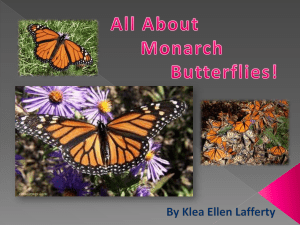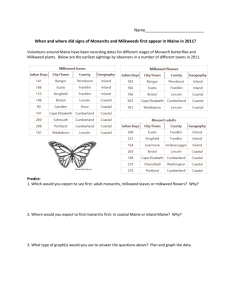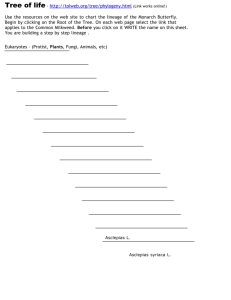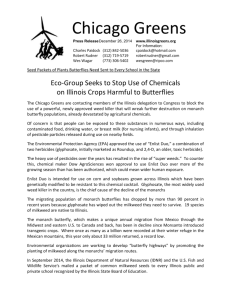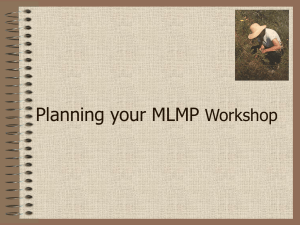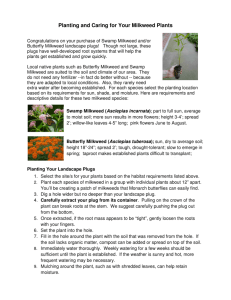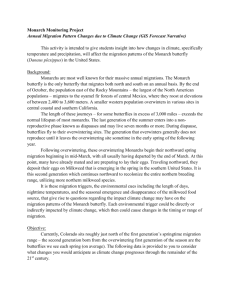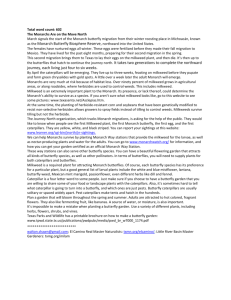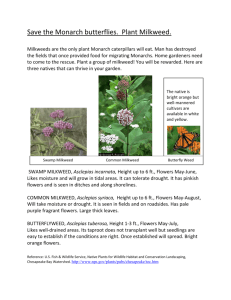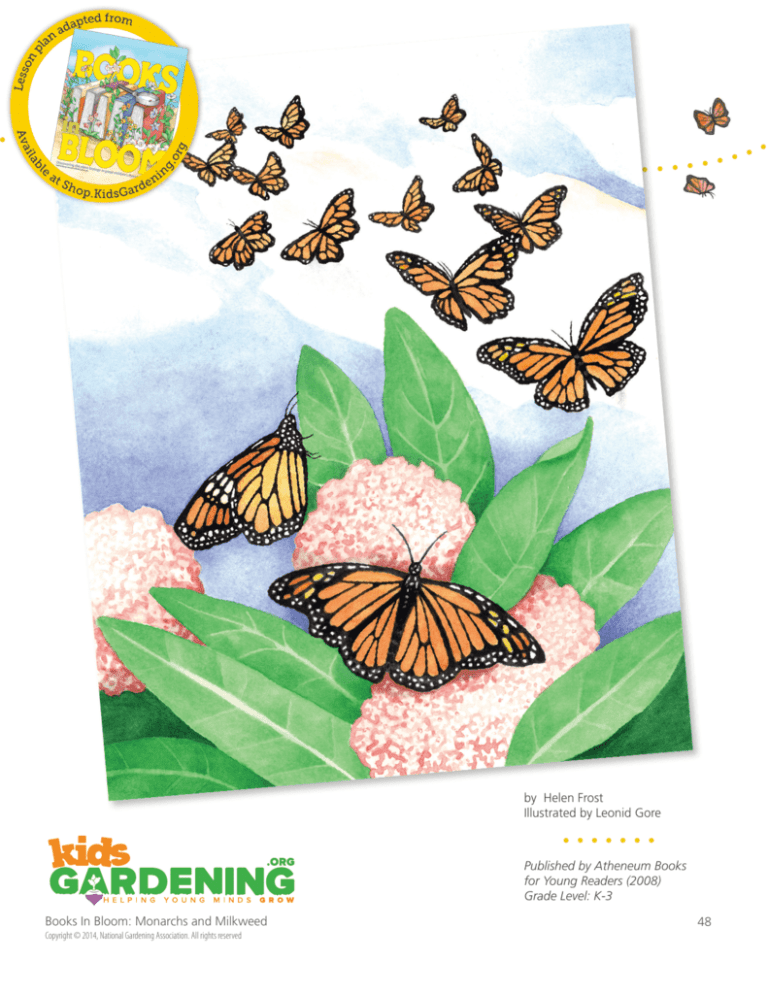
by Helen Frost
Illustrated by Leonid Gore
Published by Atheneum Books
for Young Readers (2008)
Grade Level: K-3
Books In Bloom: Monarchs and Milkweed
Copyright © 2014, National Gardening Association. All rights reserved
48
Monarch and Milkweed
What We Love About This Book
• Beyond the chrysalis — provides a closer look at the Monarch life cycle and the
plant that makes it possible
Discover the Book
Monarch and milkweed are made for each other, and their special relationship
is the focus of this beautiful picture book. Newcomers and butterfly enthusiasts
who are already familiar with the Monarch’s annual migration will learn about the
biological interdependence of this butterfly and the milkweed plant. The circular
structure of the book, beginning with the emergence of one milkweed seedling
and ending with another a calendar year later, also presents a complete life cycle of
the Monarch. The beginning stages of plant and insect development are presented
in parallel on alternating pages up until the moment when the butterfly first feeds
on milkweed in full bloom and their stories intertwine.
Readers will appreciate the clear illustrations. The details of the yellow, black, and
white Monarch caterpillar; stages of the chrysalis; and mature Monarch are presented
in a larger-than-life format. The softly textured pastel and acrylic paintings highlight
the close-up biological details, yet also provide panoramic cross-country landscapes
in aesthetically pleasing earth tones. Migration routes are found in the book’s end
pages, with the spring and summer northward migration at the front, and fall and
winter southward route represented at the back. An author’s note at the back
provides further information and lists relevant websites for those who want to
learn more.
Explore the Biology
This book tells the twin tales of the milkweed plant and the Monarch butterfly by
walking the reader through the life cycle of both insect and plant and illustrating
how the two intersect. Perhaps the obvious question is: why do Monarch larvae
feed on milkweed? Why not on other plants? The answer is that nature is filled
with specialized relationships; some are mutually beneficial and others benefit
only one partner. In this case, the Monarch gains at the expense of the milkweed.
Milkweed is a common plant that is best known for the role it plays in completing
the life cycle of these lovely lepidoptera. Milkweed produces a toxic compound
that tastes bitter and discourages insects and large herbivores from consuming it.
Monarchs have evolved resistance to this compound, so the larvae use this food
source without dying. They are one of the few organisms that can eat this plant; as
a result, they have little competition for their food. Even better, the Monarch larvae
accumulate the toxin and themselves become poisonous as they mature. This is
one of the reasons few birds prey upon this butterfly.
49
Books In Bloom: Monarch and Milkweed
Copyright © 2014, National Gardening Association. All rights reserved
Digging Deeper
Talking Points
1.How are the life cycles of Monarchs and milkweed interrelated?
After reading the book, ask your readers to describe the stages of the Monarch’s
life cycle, identifying when it coincides with milkweed’s. Find the images in the
text that highlight their relationship at different stages; for example, a mature
butterfly is shown landing on a milkweed in bloom and sipping nectar; later, a
developing Monarch larva is shown feasting on milkweed leaves.
2.Is this a partnership or a one-way relationship?
Ask the readers if the dynamic between the butterfly and the milkweed is a true
partnership or a one-way relationship. In other words, what does the Monarch
get from the milkweed and what does the milkweed get from the Monarch?
They should come to see that the butterfly is the clear beneficiary in this one-way
relationship because the milkweed plant serves as a food source for the developing
larvae and produces the toxin that makes the adults bitter and poisonous to
eat. The milkweed gains little from the relationship. Monarchs can pollinate
milkweed flowers, but so can moths, other butterflies, and bees. What led to the
evolution of this relationship is that few insects could eat milkweed, so there
was little competition for this food source, and the toxin protected the insect
from being eaten.
3.Can Monarchs only eat milkweed?
Using the images in the book, ask your readers what the larvae feed on (milkweed
leaves) and what the adult butterflies eat (nectar from many types of flowers).
The adults require a sugar solution to survive, and in nature this is found in
nectar-producing flowers and rotting fruit. Since many flowers produce nectar to
attract pollinators, adult Monarchs are able to feed upon many different species,
ensuring that they can eat throughout their travels, even when milkweed is not
in bloom. The larvae, on the other hand, feed only on milkweed.
Books In Bloom: Monarch and Milkweed
Copyright © 2014, National Gardening Association. All rights reserved
50
Related Books
Learning Experiences
Monarch Butterfly
Written and Illustrated by
Gail Gibbons
1.Merge the milkweed and Monarch life cycles.
To understand the parallel developmental stages of the Monarch and milkweed,
use pictures to represent the seedling-to-seedling and butterfly-to-butterfly
progression featured in the book. Have your readers color and cut out the
pictures. Using the book as a reference, first order the milkweed pictures on the
floor or glue them to a sheet of paper. Next, place the Monarch stages next to
the milkweed to show when the two life cycles intersect.
Published by Holiday House (1991)
Grade Level: 2-4
An Extraordinary Life: The Story
of a Monarch Butterfly
Written by Laurence Pringle
Illustrated by Bob Marstall
Published by Orchard Books (1997)
Grade Level: 3-6
Are You a Butterfly?
Written by Judy Allen
Illustrated by Tudor Humphries
Published by Kingfisher (2003)
Grade Level: K-3
2.Track the migration.
Monarch development and migration is a rich curricular topic, and this
multigenerational trek is one of the most beloved natural events in North
America. There are many websites that offer up-to-the-minute tracking of
the Monarch’s migration and videos of metamorphosis. Print a map of North
America and, using online resources, draw the various migration routes that
Monarchs follow. Depending on reader interest and reading levels, the map can
be as simple as the one shown on the end pages of the book, or can be made
more complex by adding layers of detail such as migration dates, generations,
speed, and specific locations en route.
3.Plant a Monarch way station.
As Monarchs make their journey north and south each year, they must find stops
along the way to refuel and reproduce. Create a way-station habitat that provides
for all the Monarch’s needs, including nectar plants for adults, milkweed for larvae,
nearby structures for chrysalis attachment, dark stones for warming in the sun,
and puddles for water. Your habitat can be planted directly in the ground, in
raised beds, or in containers. In addition to providing a temporary home for
Monarchs, your new butterfly habitat will provide the perfect location for observers.
The Life Cycle of the Monarch Butterfly
and Milkweed Plant
1
51
Seeds disperse and g
row
into
see
2 Plant gr
dlin
ows
gs.
an d
egg
s ar
e la
id.
Books In Bloom: Monarch and Milkweed
Copyright © 2014, National Gardening Association. All rights reserved
Lesson Plan
Monarch Migration Map
Objective
To explore the journey of the Monarch butterflies.
Time
8 to 10 weeks
Materials
• Map of North America
• Milkweed plants or seeds
• Monarch observation worksheet
Laying the Groundwork
Ask readers:
• What is the life cycle of a butterfly?
(Butterflies go through many changes during their lives. A butterfly
starts as a small egg, which then hatches into a caterpillar. This
caterpillar then feeds on plant leaves and grows. When it reaches
a certain size, it builds a chrysalis around itself. Even though it may
look like it is dormant and in a sleeping bag, the developing butterfly
is busy forming its wings within this structure. In the last stage of
its life, the butterfly emerges from its chrysalis and takes flight. It
eats nectar and pollen from flowers and lays eggs to complete the
life cycle. Butterflies lay their eggs on plants that caterpillars like
to eat so that as soon as the young hatch, they can begin growing.)
• What is migration?
(Migration refers to the movement of animals, usually seasonal, to
find food or more favorable environmental conditions. Monarchs
move south each fall to escape cold temperatures and north each
spring to find additional food sources.)
.
rfl
3
Ca
ter
p
tte
.
ies
em
e
rge
.
.
illa
r
s.
m
r
o
f
Chrysalis
4
feed
s on
grow
ing leaves.
Books In Bloom: Monarch and Milkweed
Copyright © 2014, National Gardening Association. All rights reserved
5
ers
w
flo
Plant
d
an
bu
52
Exploration
1.Using a map of North America, discuss the migration routes
that Monarchs follow.
2.Add dates indicating approximately when the Monarchs first
reach each stage in their journey to your map, using data
submitted to the citizen science project Journey North at
www.learner.org/jnorth/monarch/.
Data is available from 1997 to the present.
3.Brainstorm with your readers the reasons that the dates
would vary each year.
Temperatures and food availability should top the list.
4.Begin observation in your outdoor space.
Plant milkweed plants in containers, in raised beds, or in the
ground and observe regularly. Record temperatures for each
day and note how many Monarchs are observed. You can share
this data online through the Journey North website with other
observers across the country.
Branching Out Ask students to pretend they are Monarch butterflies and have them
write a diary about their journey. Make sure they understand that
an individual butterfly does not survive to fly all the way north and
back each year, but rather, multiple generations make the journey.
53
Books In Bloom: Monarch and Milkweed
Copyright © 2014, National Gardening Association. All rights reserved
MONARCHS AND MILKWEED
MONARCH OBSERVATION
NAME
DATE
Monarch Migration Map
Date
Temperature
High
Low
Books In Bloom: Monarch and Milkweed
Copyright © 2014, National Gardening Association. All rights reserved
Number of
Monarchs
Observed
Date
Temperature
High
Low
Number of
Monarchs
Observed
54
MONARCHS AND MILKWEED
NAME
MONARCH OBSERVATION
DATE
Life Cycle Stages of the Monarch Butterfly and Milkweed Plant
55
Books In Bloom: Monarch and Milkweed
Copyright © 2014, National Gardening Association. All rights reserved

